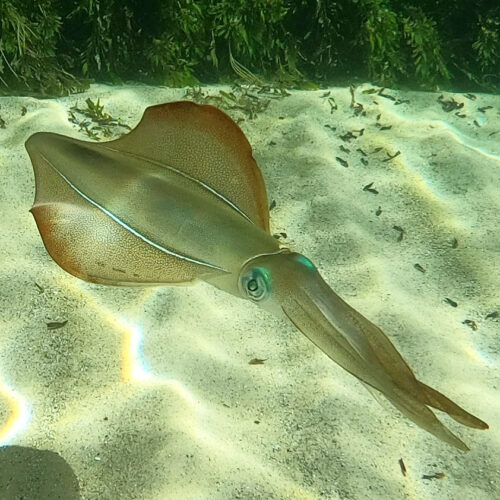
According to the Atlas of Living Australia, 26 species of cephalopods have been recorded in South Australia. These include squid, octopus, cuttlefish and nautilus. If you have photographs of any of these species, taken in South Australian waters, please contact us.
| Genus | Species | Common name | Described |
| Argonauta | argo | Greater argonaut | 1758, Linnaeus |
| Argonauta | nodosa | Knobby Argonaut | 1786, Lightfoot |
| Euprymna | tasmanica | Southern dumpling squid | 1884, Pfeffer |
| Grimpella | thaumastocheir | Velvet octopus | 1928, Robson |
| Hapalochlaena | lunulata | Greater blue-ringed octopus | 1832, Quoy & Gaimard |
| Hapalochlaena | maculosa | Lesser blue-ringed octopus | 1883, Hoyle |
| Idiosepius | notoides | Southern pygmy squid | 1921, Berry |
| Nototodarus | gouldi | Red arrow squid | 1888, McCoy |
| Octopus | australis | Hammer octopus | 1885, Hoyle |
| Octopus | berrima | Southern keeled octopus | 1993, Stranks & Norman |
| Octopus | bunurong | Southern white-spot octopus | 1990, Stranks |
| Octopus | kaurna | Southern sand octopus | 1990, Stranks |
| Octopus | maorum | Maori octopus | 1880, Hutton |
| Octopus | pallidus | Pale octopus | 1885, Hoyle |
| Octopus | superciliosis | Frilled pygmy octopus | 1832, Quoy & Gaimard |
| Opisthoteuthis | persephone | 1918, Berry | |
| Sepia | apama | Giant Australian Cuttlefish | 1849, Gray |
| Sepia | braggi | Slender cuttlefish | 1907, Verco |
| Sepia | chirotrema | 1918, Berry | |
| Sepia | cultrata | Knifebone cuttlefish or Elongated cuttlefish | 1885, Hoyle |
| Sepia | hedleyi | Hedley’s cuttlefish | 1918, Berry |
| Sepia | novaehollandiae | New Holland cuttlefish | 1909, Hoyle |
| Sepiadarium | austrinum | Southern bottletail squid | 1921, Berry |
| Sepiadarium | kochii | Koch’s bottletail squid | 1881, Steenstrup |
| Sepioloidea | lineolata | Striped pyjama squid | 1832, Quoy & Gaimard |
| Sepioteuthis | australis | Southern calamari squid | 1832, Quoy & Gaimard |

Southern calamari squid
(Taken by Russell Johns)
Header photo also taken by Russell Johns

Some photos of each species would be useful. I have some Nice shots. I suspect they’re of the southern squid
Hi Russell, just found your message now. Is that why you sent those earlier pics to us?. Cheers, Steve
Yep, you have a list, but no associated images. I read on the site that they would like pictures of the critters listed. I gather from some of the comments that an earlier iteration of your web page did have images.
I’ve found the iNaturalist app really good.
Thanks again, Russell
Russell, your Southern calamari squid image is a stunner.
(Personal bias declaration FWIW:- I prefer the original common name used by iNat, Southern Reef squid. But iNat has now put that in brackets ie in 2nd place).
Wrt iNat generally, I’m delighted that you support it by recommending the site.
I am addicted to iNat, and have found it a far more benign addiction than Facebook, which I quit using 3 years ago and have been happier ever since.
As for Steve’s asking for photos of as many of the SA cephalopod species as possible, I don’t want to argue with the bloke who does most of my secretarial work on top of his main role as MLSSA President, but I don’t quite understand why you Steve Reynolds would request that such images be sent to MLSSA Inc.
It seems more workable and simpler for people to put any such images directly onto iNat .
If they are willing to acknowledge on iNat that they have joined iNat because they had read Steve’s MLSSA article, that would be nice.
Perhaps by adding that image submission (=that iNat Observation ) to the MLSSA project within iNat which is what I do with every marine life iNat Observation I post.
Regards to all involved,
David Muirhead MLSSA secretary
There is no truth whatsoever in the suggestion that I asked for “photos of as many of the SA cephalopod species as possible” to be sent to MLSSA. The request probably came from a person operating under the name of the Marine Life Society. May I now call for people to put any such images directly onto iNat?